“Dawn”
Written by John Shiban
Directed by Roxann Dawson
Season 2, Episode 13
Production episode 039
Original air date: January 8, 2003
Date: unknown
Captain’s star log. Tucker is testing the new autopilot on a shuttlepod by taking it through a mess of 62 moons that orbit a gas giant. There’s also a lot of interference from selenium isotopes in many of the moons.
That latter proves a problem when a) an alien ship fires on the shuttle, b) communications go blooey, and c) both ships crash land on one of the moons, the selenium having wiped out the power in both.
Tucker wakes up and tries to effect repairs on his transceiver so he can call for help. Zho’Kaan, the pilot of the other shuttle, then shows up and steals the transceiver at gunpoint. Tucker makes a recording of his voice to use as a distraction to get Zho’Kaan away from his own crash site to steal the transceiver back. However, Zho’Kaan returns from his investigation faster than Tucker expected, and Zho’Kaan shoots him—luckily, set on stun.
Enterprise encounters an Arkonian ship. Khata’n Zshaar, the shipmaster of the other vessel, orders Archer to leave Arkonian space—he’s also pissy that there’s a Vulcan on board. (Vulcans tried the same we’ll-guide-you thing they did with humans when Arkonians developed faster-than-light travel. It did not end well.) Archer explains that he’s missing a crewmember and a shuttlepod, and Zshaar allows as how one of his scout ships is also missing. Archer convinces him to help Enterprise in a joint search operation.
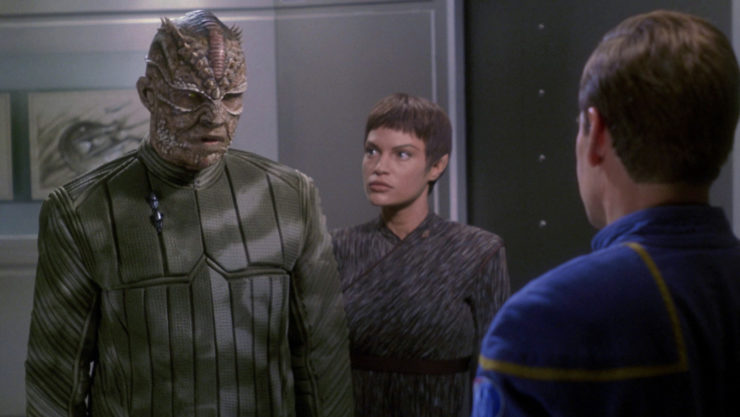
Tucker wakes up to see that Zho’Kaan is struggling with the repair work, which is probably why he left Tucker alive. Zho’Kaan convinces Tucker to take a shot at repairing the transceiver—which, of course, is what he wanted to do in the first place…
At one point Zho’Kaan offers Tucker what the latter thinks is water—it really really isn’t—and when Tucker cuts himself, Zho’Kaan spits on the wound, and it heals.
Unfortunately, Tucker needs components from the shuttlepod, but he can’t communicate that to the alien. So he tricks and subdues him, ties him up, and brings him to the shuttlepod.
On Enterprise, T’Pol reports that many of the moons have brutal daylight periods of 170 degrees. (On the one hand, she doesn’t specify if that’s Fahrenheit or Celsius. On the other hand, it doesn’t really matter much, as that’s disastrously hot regardless of scale.)
Tucker manages to repair the transceiver, but the same interference that borked ship’s systems are also keeping a signal from getting out. They need to get to higher ground. The language barrier prevents Tucker’s attempt to convey this to Zho’Kaan properly, and so when the former unties the latter, the Arkonian attacks the human.
Fisticuffs ensue, but all they do is wear each other out, and Zho’Kaan belatedly realizes that cooperation really is the smart move here.
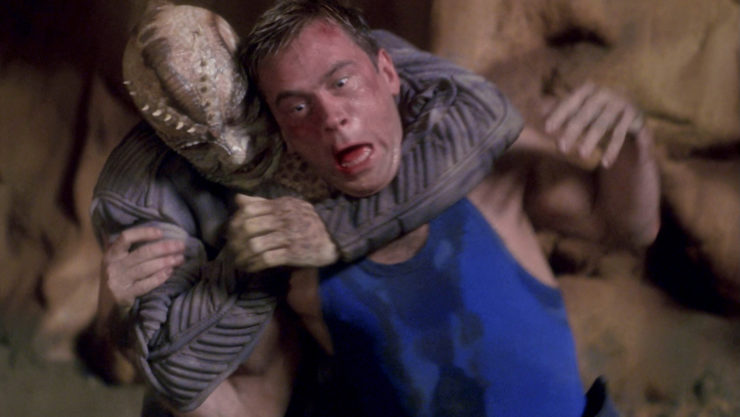
Dawn starts to break as they climb the mountain, and they get a signal through. But both are suffering the effects of the high temperatures, especially Zho’Kaan who does not appear to have sweat glands. They get through to Enterprise, but there’s a problem: it’s been established that neither ship’s support craft will be able to land safely, and Phlox reports that the transporter’s not an option for Zho’Kaan, as he won’t survive it in his current state. Tucker refuses to abandon him. He also saw enough of Zho’Kaan’s ship to be able to figure out a solution: an Arkonian shuttle can be modified to not be damaged by the selenium. Zshaar orders the modifications to be made to a shuttle, and they’re rescued.
Phlox treats both Tucker and Zho’Kaan, and the two finally get to talk for realsies.
Can’t we just reverse the polarity? Apparently, if you transport someone with acute cellular breakdown, they’ll die. So, y’know, don’t do that.
The gazelle speech. Archer is able to work with the Arkonians and manages better relations with them than the Vulcans managed after a hundred years. Which probably says more about the Vulcans than it does Archer…
I’ve been trained to tolerate offensive situations. T’Pol is suitably impressed with Archer’s ability to make nice with the Arkonians.
Florida Man. Florida Man Collaborates With Former Foe!

Optimism, Captain! Phlox puts the kibosh on transporting Tucker and Zho’Kaan back—or, at least, Zho’Kaan—because of how bad off he is in the heat.
No sex, please, we’re Starfleet. Tucker spends most of the episode in either a tank top or topless, which is especially amusing for a guy whose catch phrase is, “Keep yer shirt on.”
Buy the Book
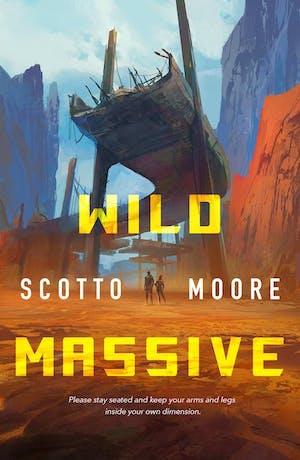

Wild Massive
I’ve got faith…
“Trip, when I fired at your vessel—I’m grateful I didn’t destroy it.”
“That makes two of us.”
–The first conversation between Zho’Kaan and Tucker in which both can fully understand each other at the end of the episode.
Welcome aboard. The two Arkonians are played by the great character actor Gregg Henry (Zho’Kaan) and Brad Greenquist (Khata’n Zshaar). Henry previously played a Son’a in Insurrection, while Greenquist previously played the beleaguered new autarch in Voyager’s “Warlord” and an alien thief in DS9’s “Who Mourns for Morn?” and will later play a Rigellian kidnapper in the fourth season’s “Affliction.”
Trivial matters: This the only significant on-screen appearance of the Arkonians, though some have been seen on Lower Decks.
When Tucker is heat-strokedly reminiscing about what he’s experienced to Zho’Khaan, he mentions seeing the Great Plume of Agosoria (“Cold Front”), riding in a Suliban cell ship (“Broken Bow” and “The Communicator”), spending the night with a princess (“Precious Cargo”), getting pregnant (“Unexpected”), and several other items that haven’t been chronicled on screen. One of the latter was seeing the ringed moons of Matalas Prime, named after Terry Matalas, at the time executive producer Brannon Braga’s assistant, and currently the show-runner for Picard.
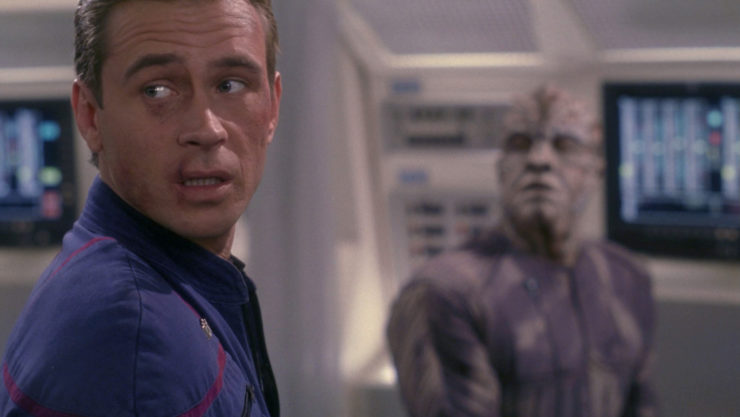
It’s been a long road… “The encounter was less volatile than I expected.” In 1968, Hell in the Pacific was released, starring Lee Marvin and Toshiro Mifune. Taking place during World War II, it chronicled the story of an American soldier and a Japanese soldier stranded on a deserted island in the Pacific, being forced to work together despite not having a common language.
In 1979, Barry Longyear wrote a science fictional version of that plot in a magnificent novella called Enemy Mine about a human and an alien whose nations were at war stranded alone on a planet and having to work together despite not having a common language—or common species. It won both the Hugo and Nebula Awards, and was adapted into a not-so-magnificent film in 1985 starring Dennis Quaid and Louis Gossett Jr.
The influence of these two stories has been tremendous, and similarly themed stories have been told throughout Trek, from TNG’s “The Enemy” and “Darmok” to DS9’s “The Ascent” to Voyager’s “Gravity.”
“Dawn” is very much the least of Trek’s forays into Hell in the Pacific territory. It’s not that there’s anything actively wrong with it, but there’s nothing particularly compelling about it. Even the 1985 film of Longyear’s novella—which was mostly awful—had some magnificent performances from the two leads to keep it going. Connor Trinneer and Gregg Henry are both fine actors, but they’re given nothing here but the most rote of story beats, and absolutely no kind of characterization. We don’t really learn anything about Tucker in this hour that we didn’t already know, and Zho’Kaan doesn’t create much of an impression. (Hell, Brad Greenquist’s Arkonian captain evinces more personality, though with him I was mostly wondering why he sounded so much like Jeff Kober…)
John Shiban’s script mostly is concerned with making sure all the Hell in the Pacific boxes are checked and not really anything beyond that. Roxann Dawson’s usual good direction is nowhere in evidence, either, though I will give her credit for the hilariously ridiculous fist fight that Tucker and Zho’Kaan indulge in before the latter finally agrees to cooperate. Both participants are, um, tuckered out (sorry…), and it’s a good example of two people who are a) bad at fighting and b) exhausted flailing at each other badly.
But overall, this episode just sits there.
Warp factor rating: 5
Keith R.A. DeCandido is involved with two Kickstarters that are launching soon: One is for three fantasy novels—Keith’s Phoenix Precinct, the latest in his fantasy/police procedural series, as well as Aaron Rosenberg’s Yeti Left Home and Ef Deal’s Esprit de Corpse—from eSpec Books. The other is for the International Association of Media Tie-in Writers’ anthology Double Trouble: An Anthology of Two-Fisted Team-Ups, featuring meetings between classic characters, edited by Keith and Jonathan Maberry, and featuring nifty team-ups by Kevin J. Anderson, Greg Cox, Delilah S. Dawson, Nancy Holder, David Mack, Scott Sigler, Dayton Ward, and many more. More information at this blog post of Keith’s.










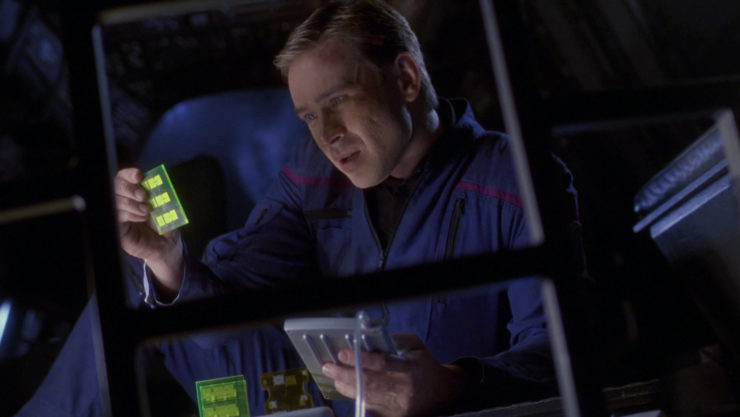
Yes, a by-the-numbers offering. I’m surprised that you gave it more points than The Communicator …
I was wondering, if it was impossible to beam both survivors out, why didn’t they beam lots and lots of ice cubes down? Or at least a reflective blanket. I mean, no weapon and no translator in the survival kits can be explained, those are expensive, but no blanket? And it wouldn’t have derailed or even delayed the plot all that much.
Yeah, clearly Enemy Mine redux, but not bad. Decent story, decentTrip focus, and it’s nice to see the occasional planetary environment that isn’t cozy and Earthlike. Although the idea that the aliens don’t drink water was silly. Water is the basis of all carbon-based life!
You didn’t like Enemy Mine? I had the impression it was pretty well-regarded.
“On the one hand, she doesn’t specify if that’s Fahrenheit or Celsius.”
Except for TOS, Trek productions usually use metric measurements by default, so I would presume Celsius.
“Apparently, if you transport someone with acute cellular breakdown, they’ll die. So, y’know, don’t do that.”
At least with early, 2150s-era transporters.
I remember finding it difficult to credit that any lifeform even remotely like a human could be incapable of ingesting water, but biology is weirder that I thought it was when I was 15 years old, so maybe it’s not impossible.
@3/jaime: Okay, but is it safe to feed Arkonians after midnight?
Enemy Mine was awful, and I was surprised that it had as high as 63% from critics on Rotten Tomatoes, which doesn’t match my memory of how it was reviewed 37 years ago, but whatever….
—Keith R.A. DeCandido
It’s possible that the character was having trouble with water specifically issued as part of a survival pack – I.E. likely optimised for Human consumption – which might also explain why Trip had problems swallowing his opposite numbers’ libation (Though I’m tempted to imagine that was actually a water bottle filled up with the Arkonian equivalent of rotgut on the sly).
Concerning the episode itself, I rather liked it: rock solid work, though not outstanding (I did like that the Arkonians are never required to soften up – they’re still undoubtedly prickly and rather disquieting even at their most collegial, which is fairly atypical for STAR TREK): it does amuse me to imagine Commander Tucker and his fellow survivor of the Dawn Barbecue running into each other years later, showing the sort of half-friendly, half-wary familiarity of men who aren’t likely to be friends but who shared experiences too intense to be indifferent to each other (“Just when I was hoping for a friendly face” “You’ll make do with me instead”).
I’m surprised that the episode used Selenium Isotopes as the explanation for the problems. I’m not aware of any, that in naturally occurring amounts that would be a significant issue for electronics. OTOH if there were some REI alloys naturally occurring in significant amounts, I could see it producing enough of a magnetic anomaly to be a issue for a Shuttlepod AND cause Transporter issues. Imagine significant Magnetic Samarium and Neodymium alloys. That IMO is far more plausible than Selenium Isotopes. Heck, even an element or compound NOT found naturally on Earth would make more sense.
@7/Charles Rosenberg: “Heck, even an element or compound NOT found naturally on Earth would make more sense.”
Except there really shouldn’t be such a thing, despite the ubiquity of the sci-fi trope of “They’re made of elements not even on our periodic table!” Even aside from the uncertainty of whether stable transuranics even exist, even aside from how heavy and rare they’d have to be, there’s the fact that all the stars in the galaxy formed out of the same clouds of stuff, getting constantly churned up and mixed together over billions of years and multiple cycles of star formation. So all the star systems in the galaxy should pretty much have the same mix of elements in them, except that maybe some of the stars closer to the galactic center might have more transuranics because they’ve been through more cycles of starbirth and death, maybe.
But yeah, it’s annoying when Trek uses a real substance like selenium or iridium and gives it properties totally unlike the real element. Heck, TOS had the sense to change the “lithium crystals” from “Mudd’s Women” to the imaginary dilithium so they could give it arbitrary properties, but by this point, Trek had gotten sloppier than that.
I’m enjoying the reviews of Enterprise, although I’ve seen it far less often than either Next Gen or Voyager. They’ve also helped me realize how much wasted potential there was in this series.
As a side note, my first exposure to the ‘enemy co-operation’ story comes from a Planet of the Apes comic from the late 1960s/early 1970s. A human with broken legs and a gorilla with broken arms were forced to work together to survive. I don’t recall it ending as well as this episode.
That’s a pretty spot assessment of the episode. It’s built on a solid foundation, but doesn’t do enough to make it stand out (and any episode that goes against Darmok has the deck stacked against them, regardless).
I do appreciate the overall solution to the plot and the ending, having Archer and Tucker both put the needs of the Arkonians first. It’s a small, but nice step for mankind in these early days of exploration, and a very Trekkian message overall.
And I did like Dawson’s direction, at least parts of it. Particularly the sunrise sequence, beautifully shot and lit by cinematographer Marvin Rush (parts of it reminded me of TNG‘s The Inner Light, and also VOY‘s Gravity).
On the other hand, it doesn’t really matter much, as that’s disastrously hot regardless of scale.
@krad: If it were the Kelvin measurement, wouldn’t 170K be disastrously cold? Not as cold as absolute zero, but still…
Eduardo: That’s why I didn’t include Kelvin among the possible scales T’Pol could’ve been referring to…. *chuckle*
—Keith R.A. DeCandido
Not a bad episode but nothing special either.
Props to this episode for the great looking aliens (in contrast to underwhelming aliens in The Catwalk last week). This was around the same time as Farscape season 3, which did so much more with less, this iteration of Star Trek was proving to be all too conventional at this point.
Regarding Trip spending most of the episode either in a tank top or topless: one amusing by-product of watching shows in HD that either were never meant to be watched in higher resolutions or didn’t properly account for them is that some of the make-up and prosthetic work becomes conspicuous. In this episode, Trineer’s painted-on abs were fairly obvious when shirtless, though they were not as distracting as some of the prosthetics in the TNG remaster.
I love Enemy Mine and I won’t hear a word against it. Preteen and teenage me must have watched it a dozen times. Other than that, I have nothing to add other than to say this show should never have tried to tackle a story that TNG did well. They had no chance of living up to it.
The episode didn’t hold a candle to Enemy Mine the story, but was almost as good as Enemy Mine the movie.
@10 & 11: It can’t be Kelvin temperature — that timeline hasn’t been created yet! :D
“It’s like talking to Porthos.”
Like many of the episodes this season, the premise of this episode is hardly original. That being said we at least get some interesting twists on the idea, at least in Star Trek terms. Having the universal translator AWOL for much of the episode means Trip and Zho’Kaan have to rely on the universal language of hand gestures, body language, voice tone and facial expression, which can be a bit hard to interpret when you’re dealing with a species you haven’t seen before. (Looking over the antecedents, it’s only really ‘Darmok’ that has a communication problem. ‘Gravity’ starts off with one then gives up partway through.) I thought it was a nice touch that they can’t stomach each other’s food or drink. Tucker refusing to be rescued without Zho’Kaan coming with him is one of those noble but stupid moments, although at least he’s smart enough to have an alternative plan ready. Maybe he’s realised that his plot armour is well and truly intact: There’s no real reason for Zho’Kaan to stun him instead of just killing him. (He does eventually ask Trip to fix the transceiver but that doesn’t seem to occur to him straightaway.) Archer again shows an ability to get alien captains to work with him by being blunt and straightforward with them and even gets a compliment from T’Pol out of it.
Still, this being Star Trek the ending’s practically guaranteed. The “other Enemy Mine” that sprung to mind for me is 30 years earlier the UFO episode ‘Survival’ did this story without the happy ending. (Gerry Anderson was going through his “gritty” phase.) There’s very little chance of that here.
I don’t really see “Darmok” as an example of the Enemy Mine (or Hell in the Pacific) subgenre. Those are stories where two enemies are forced to work together for survival. “Darmok” is a story where the two captains are trying to establish peaceful communication, and Captain Dathon chooses to put them together in a survival situation. So it’s got the language barrier and the mutual threat in common, but the emotional and thematic heart of the story is different, because both of them want to cooperate from the start rather than wanting to kill each other.
@18: Whilst you’re right, I guess what muddies the water a bit is that Picard and his crew assume for a fair chunk of the episode that Dathon has abducted him and stranded him on the surface because he wants to challenge him to a duel. So while they’re not enemies per se, there’s still the aspect of Picard having to realise he’s not his enemy and learn to trust him.
The reason I mentioned element not found naturally on Earth is that while we currently lack the technology to produce relatively stable Transuranic elements (we can’t generate sufficient neutron flux and IMO our current modelling of the Atomic Mass of relatively stable Transuranic elements is decidedly on the low side based on empirical evidence of existing isotopes) doesn’t mean that other more advanced societies either found them occurring naturally (in places like hypergiant stars or their daughter elements in supernova remnants) or found a way to generate the required neutron flux to produce them artificially.
For the sake of argument, let’s say that such metastable elements have half lives on the order of hundreds of thousands of years. Now let’s say that the presence of such elements in detectable quantities is the result of a catastrophic accident (presumably in space). That would explain why the Shuttlepod was affected AND the negative effects on the Arkonian.
It’s not easy to thread the needle without resorting to either complete technobabble or giving unrealistic properties to known elements, molecules etc. We have to factor in the a series like Star Trek takes place a minimum of 150 years in the future (time from the premier of Enterprise to the events in Broken Bow). We can only speculate on the advances Humanity would make in that timeframe. Let’s say that in the next few decades we DO manage to make Fusion a viable process for power generation. From there, let’s assume that with Fusion based power generation we can produce far more powerful particle accelerators. Maybe at that point we could generate the neutron flux needed to discover additional elements (or isotopes of existing elements). Let’s say we find that an “island of relative stability” does exist for superheavy elements. Current theory is that such elements would have unusual properties due to relativistic and quantum effects.
Finally, consider one other possibility using an existing element. Tantalum 180 has an metastable energy state that is observationally stable (half life several orders of magnitude older than the age of the universe). It’s the rarest known naturally occurring isotope in existence. Suppose that there are places where it occurs in sufficient quantity to produce unusual effects in both equipment and biological processes. Perhaps a species found a way to produce the metastable state of Tantalum 180 in significant quantity AND unfortunately found out that it had lethal negative effects and not only abandoned the production, but scattered what they had produced in an uninhabited star system. That sets up the premise of this episode without resorting to pure technobabble or using well known elements in unrealistic ways (although Selenium toxicity is very real so the biological effects on the Arkonian aren’t completely unbelievable).
@20/Charles: Okay, fair points. I’m just tired of the sci-fi trope of inventing imaginary transuranic elements to be the miracle substances of the future. If anything, the miracle substance of the future is turning out to be good ol’ lightweight number 6, what with carbon nanotubes, graphene, self-healing composites and polymers, etc. Of course it’s a handy story contrivance to be able to make up dilithium or deutronium or dysonium or vibranium or spacium and say it can do whatever the plot requires; but it’s a cliche and an easy shortcut, so I don’t care for it.
You know, these reviews are beginning to make me wish I hadn’t wasted my time watching Enterprise….yep, it was Enemy Mine. It ticked the boxes. Even when I was watching it the first time i was bored. Too bad the phaser wasn’t set to kill – that at least would have made me sit up and take notice….
I didn’t know Enemy Mine was a good book, though nor did I know it was based on an older movie– so there’s that at least. :-)
@22/nicholascaldwell: “I didn’t know Enemy Mine was a good book”
A novella, actually. Although the novella’s author, Barry B. Longyear, collaborated with David Gerrold on the novelization of the movie, weirdly enough.
I took “Darmok” as TNG’s riff on “Arena” more than anything else. Only what if the two captains want to be friendly instead?
I thought this one was a little above average. Growing up on TNG, it basically reminded me of “The Enemy”, and of course, Enemy Mine, the latter of which I haven’t seen since being a kid but I’d like to see again. I did prefer “The Enemy” to this episode, however, mainly because the former had the subplot of Worf refusing to be a donor for a Romulan, plus the other subplot of Picard dueling with Tomalok. But the dangers and misadventures of Geordi and the Romulan vs. Tucker and his adversary seemed basically on par with each other.
Regarding the quality of Enemy Mine, I had really fond memories of the movie as well, but when I eventually went back to rewatch it, I realized that the scenes between Louis Gossett Jr. and Dennis Quaid, which is what I mostly remembered, only make up part of the movie. The rest of it does not come anywhere near to matching the quality of their interactions, so I understand why it isn’t that greatly regarded overall.
@26/northman: Well, all this has gotten me curious, so I just put the Enemy Mine DVD on hold at my library.
@7 – A comedy sci-fi movie called Evolution, starring David Duchovny, came out a year prior. It was probably hitting the video stores shortly before the writers tackled the script.
The aliens were vulnerable to Selenium, through some ludicrous logic that works because it’s a comedy).
So I’m guessing they copied it and somehow made the idea worse.
@26/northman: I also don’t remember Enemy Mine having any scenes other than between the two leads. So maybe the non-Quaid/Gossett parts dragged the movie down. I’ll have to give the film a rewatch myself.
I have this feeling that a lot of sci-fi space movies that came out in the ‘80s were generally compared to the Star Wars films and were seen as cheap knock-offs. I’m thinking only the Star Trek and Alien franchises escaped that large shadow.
Okay, I just finished rewatching Enemy Mine. Basically, it’s 2/3 of a pretty great film bracketed by 1/3 of a pretty bad film. The opening space battle sequence is badly acted, designed, and shot, with the FX so mediocre I was surprised to see that ILM did them. Once our two leads crash on the planet, though, the production values improve with impressive creature effects by Chris Walas, and the story of the two enemies initially hating each other, then cooperating to survive on a hostile planet, bonding, and eventually becoming dear friends is effective and ultimately rather moving. Lou Gossett gives a fantastic performance as Jeriba, and though Dennis Quaid is a bit broad, he’s pretty good and has a good rapport with Gossett. The alien culture is nicely drawn, and the makeup and performance techniques to make the actors as alien as possible are effective (though the way the makeup just has a big hole in it so you could see the actor’s mouth always bugged me).
But in the final act, it falls apart. It turns into an overdone action movie as Davidge fights the slavers, and all the stuff set up in the first two acts about the territorial war between humans and Dracs and the bitter enmity between them is just ignored in favor of a pat, rushed happy ending. In my distorted memory, I thought that Davidge was rescued and had to try to stop his military cohorts from killing Jeriba or the child, or something like that, but the military’s suspicion of his possible collaboration with the enemy is barely touched on and then forgotten at the end. It’s quite incoherent, and a very disappointing payoff to something that was really quite compelling most of the way through.
I wonder if the casting of Bumper Robinson as the Jem’Hadar foundling raised by Odo in DS9: “The Abandoned” was a nod to his similar role in this film.
@CLB – A much better explanation/review than mine, but I definitely agree with it.. In retrospect, it makes sense that I had previously forgotten the opening sequence and the last act. The great stuff sticks with you, the not so good slips away. Probably a lesson in that somewhere.
@31/northman: Apparently the original “Enemy Mine” novella focused more on how the rescuees were ostracized by their own cultures after their rescue, which would’ve been more worth seeing. IMDb’s trivia page says that the studio insisted on adding the slave mine subplot because the execs didn’t understand that the title was a poetic way of saying “my enemy” and insisted that a story called Enemy Mine needed to have a mine in it. I’m not surprised; the action climax did feel totally tacked on and imposed by studio meddling. It’s a shame.
It’s funny to me that you thought the Arkonian captain sounded like Jeff Kober, krad, because I thought he looked like Brian Thompson, and I’m always confusing Thompson and Kober with each other.
My big head-scratcher coming out of this episode hasn’t been mentioned yet here: Trip and Zho’Kaan were rescued by an Arkonian shuttle. So why did that shuttle take them back to Enterprise instead of an Arkonian ship? That would have made so much more sense; Zho’Kaan was the one who needed medical attention, and better he get that from one of his own doctors instead of from Phlox.
A couple lines of dialogue could have taken care of this little plot hole, but I don’t remember hearing anything to that effect.